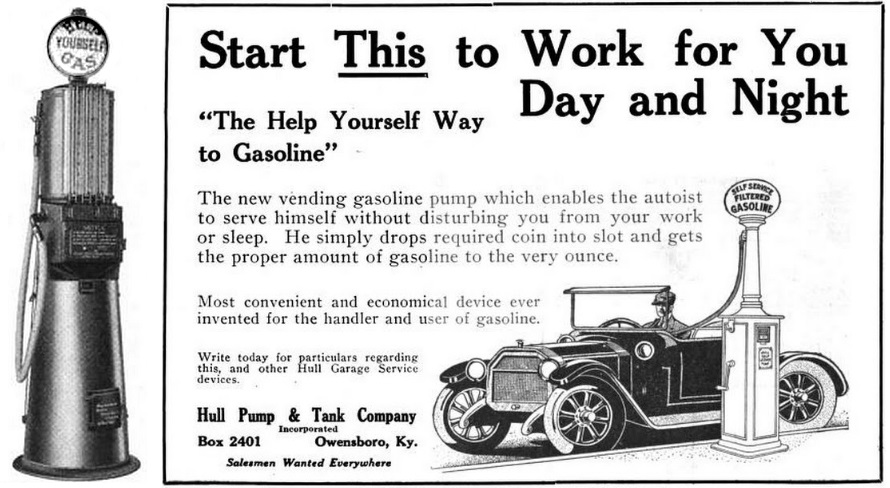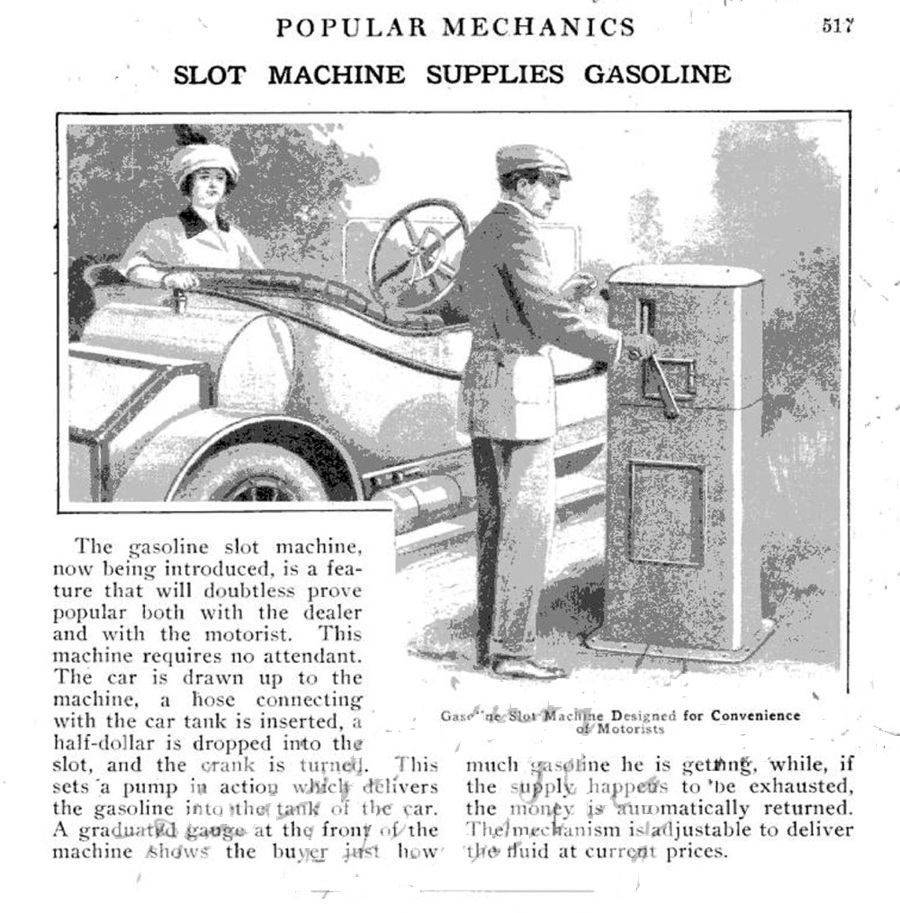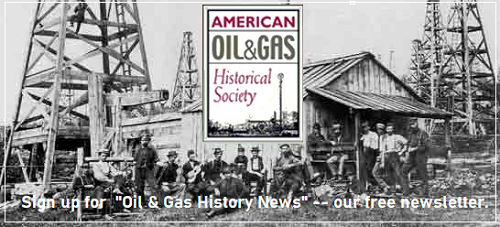“Drop the coin in the slot…Mr. Robot delivers the correct amount of gasoline.”
Almost as soon as gasoline service stations appeared, inventors began experimenting with ways to make user-friendly pumps for consumers. The revenue possibilities of 24-hour self-service gasoline pumps prompted a number of innovators to develop coin-operated systems in the early 20th century.
Self-measuring pumps once used to dispense kerosene were adapted for gasoline (see Wayne’s Self-Measuring Pump), even as inventors sought ways to automate payment at the pump.
Scientific American and Popular Mechanics featured some of the early designs for coin-operated gasoline pumps, noting that manufacturers took their cue from “the fortunes that have resulted from the harvest of pennies dropped into chewing gum slot machines.”

Trade magazines like Garage Dealer and Motor Age featured advertisements for coin-operated gas pump technologies of the 1920s.
But a coin-operated pump had risks, noted editors at Scientific American: “It is evident that a vending machine liable to hold fifty or a hundred half-dollars would be a magnet for thieves.”
The Anthony Liquid Vending Machine Company designed its “Anthony Automatic Salesman,” which the company marketed to garage owners, promising a savings of $5 in overhead costs for every dollar invested in the automatic, coin-operated pumps.
In Minnesota, William H. Fruen received the first U.S. patent for a coin-operated liquid dispensing apparatus in 1884. The inventor from Minneapolis designed an innovative “Automatic Liquid-Drawing Device,” according to Canadian historian K.J. Zeoli.
Starky Coin-Operated Pumps
One of the better-known coin-operated pump manufacturers originated with the Starkey Oil and Gas Company of Fort Collins, Colorado. Lewis P. Starkey, who first filed an application in October 1920, received his U.S. patent on November 29, 1927 (patent no. 1650882), which used electricity instead of a manual cranking system.

Patent drawing of “Self-Operating Filling Station,” the coin-operated gasoline pump invented by Lewis Starkey of Fort Collins, Colorado.
According to Zeoli, the L.P. Starkey Pump Company, which was later sold to Gas-O-Mat Inc. of Denver, produced two models of coin-operated pumps.
“Starkey and his wife ran a service station in Fort Collins. Starkey was constantly being awakened during the night by tourists who wanted gasoline. His wife actually came up with the idea of making a gas pump that would dispense gas without Starkey having to get out of bed and service the tourist. This gave Starkey the idea for the coi-operated pump.”
“Unfortunately, Starkey allowed his patent to expire on one of the key components in his pumps,” Zeoli reported. The component, a “silent mercury switch” that prevented electrical circuit sparks, “went on to be used by thousands in the construction business.”
Although coin-operated pumps at gas service stations would prove impractical, there were notable attempts in the early 20th century, according to Zeoli.
With the price of gas around 22 cents per gallon, the October 18, 1913, issue of Popular Mechanics featured a hand-cranked gasoline “slot machine.”

“This machine requires no attendant,” reported Popular Mechanics in 1913. Motorists could simply insert a half-dollar coin into a slot and turn a crank to pump gas.
In Popular Mechanics, the automatic pump was “touted as one of the first consumer friendly slot gas machines of the era,” Zeoli explained in a 2023 post on his Vintage Gas Pump & Oil History.
“The pump was so advanced, if a customer dropped a coin into an empty pump by mistake, the pump would return the coin after the first crank of the pump,” added Zeoli, a longtime collector and vintage pump expert.
Meanwhile, gasoline filling stations with uniformed attendants continued to expand nationwide following Gulf Oil’s example in Pittsburgh (see First Gas Pump and Service Station). Starkey Pump Company and a few other rare gas-pump-slot-machines examples survive in museums.
End of Gas-O-Mats
Gasoline dispensing automation seemed like a good idea, simply lacking the technology to make it work. Attempts continued as commercial names like Beacon, Gas-O-Mat, and others disappeared in a flurry of patents that could not overcome challenges of coin-operated pumps.
“You can sell gasoline 24 hours a day and 365 days a year, without effort on your part,” one company proclaimed, adding that paying was a simple process for consumers. “Drop the coin in the slot — a quarter, half-dollar, or a silver dollar, and Mr. Robot delivers the correct amount of gasoline.”
By 1915, an article in National Petroleum News reported a key drawback of unattended, coin-operated pumps: “One gasoline vending outfit tried out recently in a middle western city returned about $2 in real currency and $37 in lead slugs, buttons, and counterfeit coins for its first 500 gallons of gasoline.”
Nonetheless, as a system for numbered highways was established, and U.S. 66 from Chicago to Los Angeles was approved in 1926 (learn more in America On the Move), some coin-operated machines survived into the 1930s.
__________________________
The American Oil & Gas Historical Society (AOGHS) preserves U.S. petroleum history. Please become an AOGHS annual supporter and help maintain this energy education website and expand historical research. For more information, contact bawells@aoghs.org. Copyright © 2025 Bruce A. Wells. All rights reserved.
Citation Information – Article Title: “Coin Operated Gas Pumps.” Authors: B.A. Wells and K.L. Wells. Website Name: American Oil & Gas Historical Society. URL: https://aoghs.org/technology/coin-operated-gasoline-pumps. Last Updated: November 21, 2025. Original Published Date: July 11, 2018.




